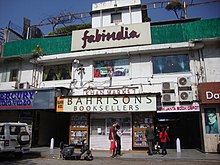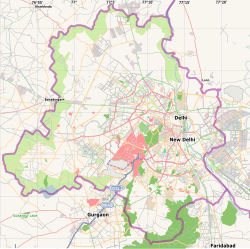This article needs additional citations for verification. (January 2021) |
Khan Market is a shopping district and retail market in New Delhi, India. It was established in 1951 by the newly constituted Republic of India's Rehabilitation Ministry to give economic opportunities to refugees of the Partition of India, especially those from the North West Frontier Province (NWFP), now Khyber Pakhtunkhwa, a province in Pakistan. Many such refugees had arrived in the Delhi region. It is named after Khan Abdul Jabbar Khan, also known as Dr. Khan Sahib, who was the Chief Minister of NWFP from 1945 to 1947, and who had helped many refugees to escape without harm. Khan was the elder brother of the Pashtun- and Indian-freedom activist Khan Abdul Gaffar Khan ("Frontier Gandhi").[1] In 2019, Khan Market was rated as the world's 20th most expensive commercial street by Cushman & Wakefield.[2][3][4]
Khan Market | |
|---|---|
| Coordinates: 28°36′01″N 77°13′36.5″E / 28.60028°N 77.226806°E | |
| Country | India |
| State | Delhi |
| Metro | Khan Market |
| Languages | |
| • Official | Hindi |
| Time zone | UTC+5:30 (IST) |
| PIN | 110003 |

History
editEstablished in 1951, the U-shaped, double-storey market complex originally had 154 shops and 74 flats on the first floor for shopkeepers.[5] Many of these shops were allocated as seed land to immigrants from the North-West Frontier Province after the partition of India, Khan Market is named in honor of Khan Abdul Jabbar Khan, a Pashtun political and spiritual leader.[6]
Nearby is Sujan Singh Park, New Delhi's first apartment complex, built in 1945, and designed by Walter Sykes George and named after the grandfather of this enclave's most famous resident, writer Khushwant Singh.[7] George also designed, the Ambassador Hotel next door, built in 1945 in a mix of British and Art Deco style. The building is now a heritage property and the hotel has been taken over by the Taj Vivanta chain.[8]
Until the 1980s, all the flats on the first floor continued to serve as homes. Neighbourhood grocery stores and middle-class shops existed in the middle lane, despite the fact it catered most up to upmarket Golf Links, Sundar Nagar, and diplomatic crowd from Chanakyapuri. Gradually, the real estate boom and expanding families of the first generation of occupants forced many families to move out. Thus these homes were sold and started being converted into shops. By the 2010s, only a few families were living in these two-room flats.[5]
A 2011 Cushman & Wakefield survey ranked Khan Market as the world's 21st most expensive shopping street.[5]
Overview
editToday it has grown to become one of the most expensive commercial real estate locations in the city. It has a wide variety of stores, including modern showrooms of most of well-known brands, silver jewellery stores, delicatessens, bookstores, paints and hardware stores, electronics, kitchenware, and fabric stores mingle with some of the better restaurants.
It is also famous for food including kebabs and gol guppe (a type of popular street food) and a retail market for lighting fixtures on the ground floor. There are several bookstores in the market[9]
Location
editKhan Market is almost in the heart of the city, close to India Gate. It is surrounded by residential complexes — government owned and private — including Golf Links, Lodhi Estate, Shahjahan Road, Pandara Road, Rabindra Nagar and Sujan Singh Park. Its environs are home to a significant number of bureaucrats from the central government (including some MPs from both the houses), and famous people like the satirist Khushwant Singh. It is one of the greenest pockets of the city, very close to the famed Lodhi Gardens. Also in proximity are the India International Centre, the India Habitat Centre, offices of the World Wide Fund for Nature, and other organizations. Nearby the Khan Market are popular schools such as Sardar Patel Vidyalaya and The Raghubir Singh Junior Modern School.
Transport
editIt is serviced by the Khan Market underground station of the Delhi Metro (Violet Line), which lies in front of the Taj Vivanta Hotel. There are four exits of the metro station namely Gate 1, Gate 2, Gate 3 and Gate 4. The exit at Gate 4 leads to Khan Market.
See also
edit- Arabber
- Bazaar
- Bazaari
- Hawker centre (Asia) a centre where street food is sold
- Market (place)
- Pan Bazaar
- Peddler
- Retail
- Street vendor
- Street food
References
edit- ^ Lakhani, Somya (17 May 2019). "Khan Market's humble beginnings: Meant for refugees, 'doomed to fail'". Indian Express. Retrieved 14 October 2021.
"This market was set up for those who had been displaced; refugees who had migrated from the North West Frontier Province (NWFP) ..." said Sanjiv Mehra, president of Khan Market Traders' Association and owner of Allied Toy Store.It was aptly named after popular NWFP leader Khan Abdul Jabbar Khan or Dr Khan Sahib, the elder brother of Pashtun Independence activist Khan Abdul Ghaffar Khan or Frontier Gandhi.
- ^ "Delhi's Khan Market is world's 21st costliest high street". The Times of India. 23 September 2010. Archived from the original on 3 November 2012. Retrieved 23 September 2010.
- ^ "Delhi's Khan Market world's 21st costliest street". The Times of India. 24 September 2010. Archived from the original on 3 November 2012. Retrieved 24 September 2010.
- ^ "New Delhi's Khan Market India's costliest street, world's 21st". Hindustan Times. 25 September 2010. Archived from the original on 25 September 2010. Retrieved 25 September 2010.
- ^ a b c "Home is where the mart is". Mint. 13 July 2012.[permanent dead link]
- ^ "The other Khan Chacha", The Hindu, 24 October 2009, retrieved 20 November 2009,
... Khan Market itself is named after a pathan, the legendary Khan Abdul Ghaffar Khan ...
- ^ "Making history with brick and mortar". Hindustan Times. 15 September 2011. Archived from the original on 5 December 2012.
- ^ Ambassador Hotel Taj Vivanta.
- ^ "Khan Market". Archived from the original on 30 March 2017. Retrieved 15 July 2012.
